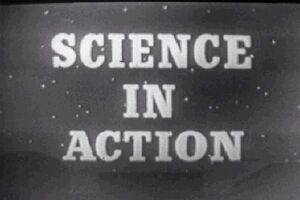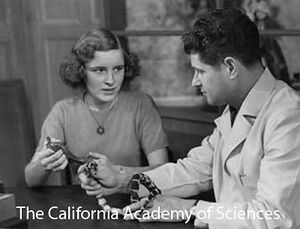Series:Science in Action
Science in Action is a series that ran from 1952 to 1966, produced by the California Academy of Sciences in Golden Gate Park, San Francisco.
The series began in 1950 as a popular 15-minute segment on a popular Bay Area television program, The Del Courtney Show. Tom Groody discussed scientific topics and animals. Eventually, Groody’s Science in Action segment became a regular 13-week feature on the program, presenting contemporary science issues.
Installments
- 029 Science in Action - Termites (1954?)
- 035 Science in Action - PLANTS and Fairyland ()
- 079 Science in Action - Powerful Poisons (1953)
- 101 How Man Measures (1954) - The concept of measuring distances is very ancient although the methods devised by man in every civilization were crude. Yet from these crude beginnings eventually came the use of scales and balances and gradually evolved the metric system which we now use. In this episode Dr. Robert C. Miller, director of the California Academy of Sciences, visits with O.C. Skinner Jr., sealer of weights and measures, City and County of San Francisco.
- 146 Science in Action - The Flow of Heat (1954)
- 193 Science in Action - Andes Expedition (1955)
- 209 (1955)
- 379 The Chair ()
- 405 Religious Archeology (1957) - In this season of Science in Action series is a resumption of up-to-date reports on scientific work hosted by Dr. Earl S. Herald, Curator of Aquatic Biology at the Steinhart Aquarium. Guest scientists, who are experts in the various subjects, join Dr. Herald to tell of advances in their fields. Dr. Herald concludes each episode by introducing the animal of the week.
- 406 Solar Energy
- 426 X-rays (1957) - In this season of Science in Action series is a resumption of up-to-date reports on scientific work hosted by Dr. Earl S. Herald, Curator of Aquatic Biology at the Steinhart Aquarium. Guest scientists, who are experts in the various subjects, join Dr. Herald to tell of advances in their fields. Dr. Herald concludes each episode by introducing the animal of the week.
- ? 1956 Science in Action - Radar Defense Screen
- ? 1956 Science in Action: Drilling for Oil
- ? 1956 Science in Action - Aero Medicine
- ? 1956 Science in Action - Rivers of Ice
- ? 1956 Science in Action - Submarines
- Science in Action, Nov. 28, 1955 - Earth's Backbone
- Transistors. Written by Draper, Benjamin.
- Science of Baking
- 569 “Bird Island” aired February 7, 1960. Lewis Wayne Walker and Dr. Earl S Herald discuss the preservation of Raza Island and the efforts to save the birds from extinction.
Description, via California Academy of Sciences
In the spring of 1950, “Science in Action” began as a fifteen minute segment on a popular Bay Area television program called “The Del Courtney Show.” Academy staffer Tom Groody made a guest appearance on the program during which time he discussed scientific topics and brought in animals from the Academy’s Steinhart Aquarium. The segment was wildly popular and Groody was invited to return and further discuss contemporary science issues. Eventually, Groody’s Science in Action segment became a regular thirteen week feature in the program.
Shortly thereafter, a half-hour weekly evening television series was developed to discuss timely and significant scientific subjects with guest scientists, demonstrations, and an animal of the week exhibition. By fall of 1950, the “Science in Action” television show was the first live science program on television in the country and forged the path for science programs as we know them today.
In 1952, California Academy of Sciences superintendent Dr. Earl S. Herald took over the role as host of Science in Action. Herald’s spontaneity and charm quickly put guests at ease and made the topics easily understandable for the audience at large. The program raised public awareness and increased traffic to the Aquarium, especially the animal of the week exhibition, which featured wild animals on live television. In one reported incident, newly born water snakes had escaped from the set of Science in Action into the television studio during a live broadcast. Because of this publicity, over five thousand people stopped in to the Aquarium the following week asking to see the baby snakes. Additionally, it was not uncommon to see a handler get bit or an animal defecate and without missing a beat, Herald would offer the clever banter that endeared him to home audiences. In June of 1966, due to rising costs of production, Dr. Herald hosted the 626th and final episode of “Science in Action”.

